2013 Can-Am Maverick 1000R, 2014 Maverick MAX 1000R Unveiled
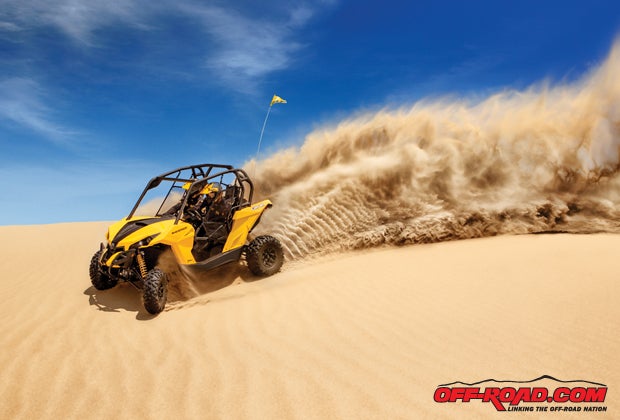
In the current state of information at the touch of our fingers, some news is hard to contain. Can-Am planned to unveil something new, something big in its side-by-side division last night at a press conference for media and southwest U.S. dealers in Southern California. Somehow. Bits of information leaked leading up to the launch, as both images and the name ďMaverickĒ were found on forums and websites within the last week. However, the details of the new Maverick 1000R, other than having the appearance of a performance machine, were still not out in the public eye.
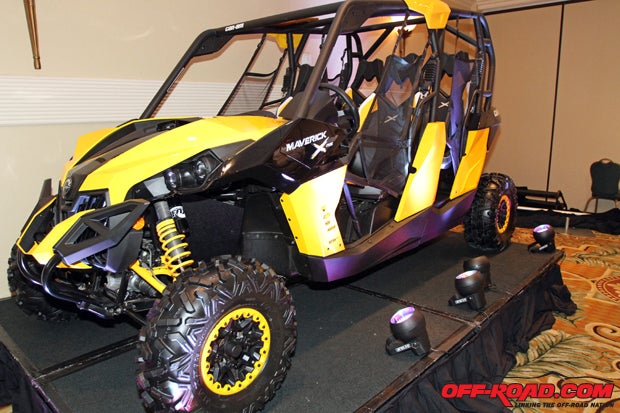
Can-Am still had some tricks up its sleeve, too, because other than launching the Maverick 1000R with an engine that will make it the most powerful side-by-side on the market (with a 102 horsepower rating), the company also unveiled a four-seater version of the Maverick (the 2014 MAX 1000R) that will be released later in 2013. It was very big news for the company, which is unveiling these new products to the public this evening at the Sand Sports Super Show in Southern California.
More Photos:
2013 Maverick 1000R, 2014 Maverick MAX Gallery
The new Maverick 1000R is not a machine Can-Am expects will simply compete in the performance side-by-side market Ė they hope to make a statement with the machine and even gain market share. Can-Am engineers not only went to work on the engine to make it more powerful, but they also completely redesigned the body and suspension on the Maverick 1000R. This is not simply a Commander with nicer shocks and more power.
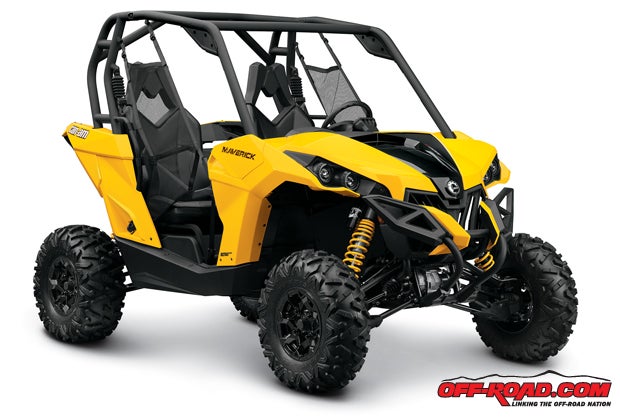
When it comes to the powerplant on the Maverick, Can-Am employs its powerful 976cc V-twin engine for the machine. If youíre a spec guru, youíll know that this engine produces 82 horsepower on the 2013 Outlander 1000 X mr ATV and the 2013 Commander UTV. So where does the extra 19 horsepower come from? High-flow dynamics is a key change to the Maverickís powerplant, which Can-Am explains will ďreduce restrictions to the flow of air, air-fuel mixture and exhaust gases to improve efficiency.Ē
This is accomplished with optimized intake systems that allow more air to flow to the engine, which include independent intakes runners that allow fine-tuning to each cylinder, a larger air intake under the glove box, and a plenum volume increase of 30 cubic inches. The engine itself gets fitted with high-flow cylinder heads with largest intake and exhaust valves, and its compressions ratio is bumped to 12.0:1 (versus 10.5:1). The CVT (Continuously Variable Transmission) is also outfitted with a new Zylon belt to handle this increase in power, which Can-Am says is 1.6 times more resistant than Kevlar. The Maverick is fitted with a high-flow twin exhaust with tuned manifold lengths and a resonator chamber, and Can-Am also fitted the machine with a catalytic converter to address any future emission needs.
The Maverickís engine is designed to optimally run on 91-octane fuel, but it does include a knock control sensor that will allow it to run on 87-octane fuel without damaging the engine (91 is optimal, of course). This all leads to 15% more horsepower than the Polaris RZR 900 XP and 30% more than the Arctic Cat Wildcat. Can-Am also claims best-in-class power-to-weight ratio that is 5% better than the RZR and 31% better than the Wildcat.
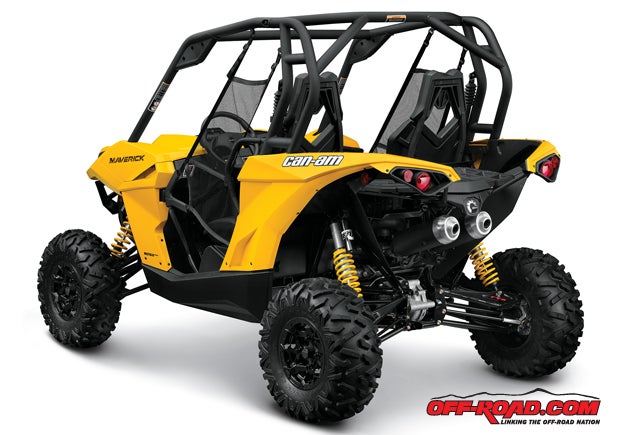
Can-Am wanted to make sure the Maverick was just as impressive in the handling department as it was in the power department. First off, the engineers went to work on the platform. Although the Maverick shares much of the mid-section of the Commander (frame, roll cage and cockpit), but the front section is extended with a 6.25-inch longer front sub-frame, a new three-inch-longer A-arm suspension designs, new Fascia and hood panels. The rear is extended 2.3 inches on the sub-frame and features new TTA (Torsional Trailing A-arms) rear suspension and new tail panels. Overall, the Maverick offers the highest frame rigidity to provide ideal suspension calibration (with minimal frame flex) and improved driver feedback.
The Can-Am engineers went to great lengths repositioning the mid-section rearward to improve the weight distribution and improve vehicle dynamics, which ultimately will aid in providing ideal steering and traction. The Maverick also features 13 inches of ground clearance. In the cab, the front cockpit is designed to provide ideal ergonomics for driver and passenger that Can-Am says provides improved side-to-side space compared to competitors.
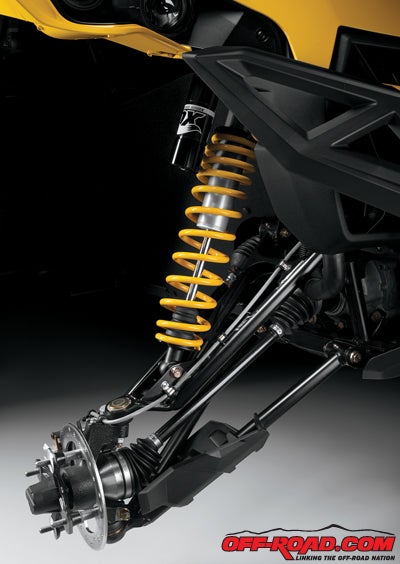
Up front, the Maverick features double A-arm front suspension with Fox Podium X Performance 2.0 piggyback shocks that provides 14 inches of travel. The 6-inch-long Fox shocks feature a dual-rate springs with preload adjustability and compressions adjustability and feature a specially formulated oil designed for the Maverick. The shocks are also fully rebuildable for servicing and valving changes. The new TTA suspension at the rear features a newly designed compact version of a five-link suspension that combines the work of two links while the fifth is the toe-control link. The compact design requires less protection against trail damage and features the lowest unsprung weight. It also has no bump steer, toe change or chamber change, and Can-Am explains it has the lowest amount of scrub compared to its direct competitors (RZR XP 900, Wildcat 1000).
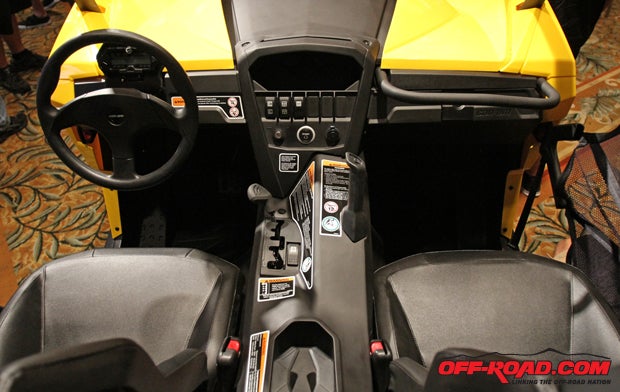
The Maverick 1000R is equipped with a center-less 12-inch cast-aluminum wheel fitted with Maxxis Bighorn 2.0 tires. A Visco-Lok front differential is equipped on the Maverick that is essentially an automatic locking differential that has no rev or speed limiter (meaning it will engage when needed).
Thereís a great deal of engineering that went into the Maverickís frame and suspension design to make both the power and handling all complement each other. Overall, Can-Am says the package results in ďdynamic behavior that is nimble and athletic, yet predictable and confidence-inspiring.Ē
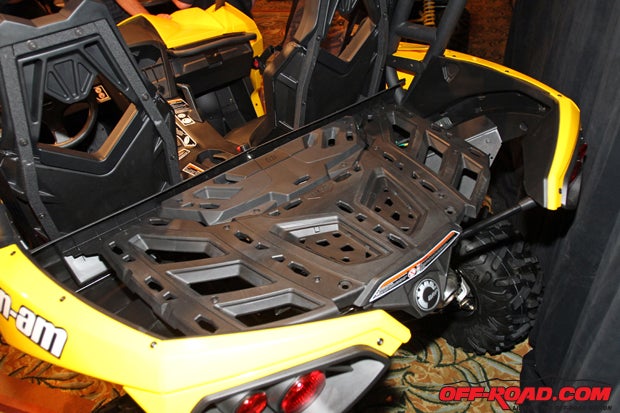
Although performance is the mindset of the Maverick, it does feature a 200-pound rear rack with LinQ quick-attach system, allowing for either small items or the installation of an optional bed liner. For the driver, thereís tilt steering and an adjustable seat for comfort. Can-Amís D.E.S.S. (Digitally Encoded Security System) anti-theft system is equipped on the Maverick as well.
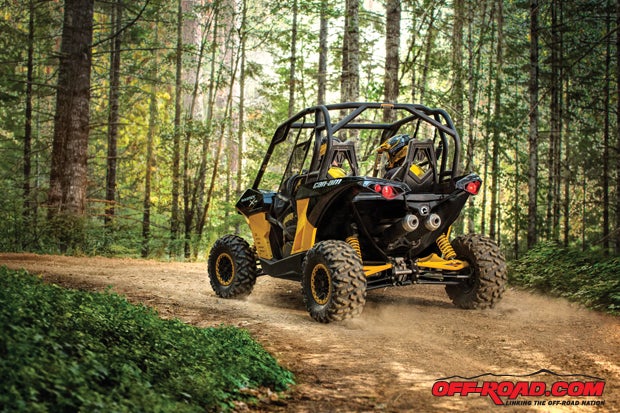
The Maverick 1000R will also be available in an X rs package that offers some additional upgrades. The X rs will feature larger front and rear Fox Podium X RC2.5 piggback shocks that feature dual-speed compression, with rebound and preload adjustments. Although based on the same center-less wheel on the standard Maverick, the X rs will feature 12-inch beadlock wheels. The instrumentation will feature both an analog and digital gauge (vs. the digital gauge on the standard Maverick), a custom steering wheel with brushed aluminum center, the X package seat trim and graphics featuring a yellow-and-black color scheme. A host of Can-Am accessories will be immediately available as well for the Maverick, including a Baja-style spare tire holder and Pro Armor Quickshot wheel jack, sport aluminum doors, off-road lights, Bimini roof with sun visor, underbelly protection and rock slider protection. Overall, there will be more than 70 accessories available.
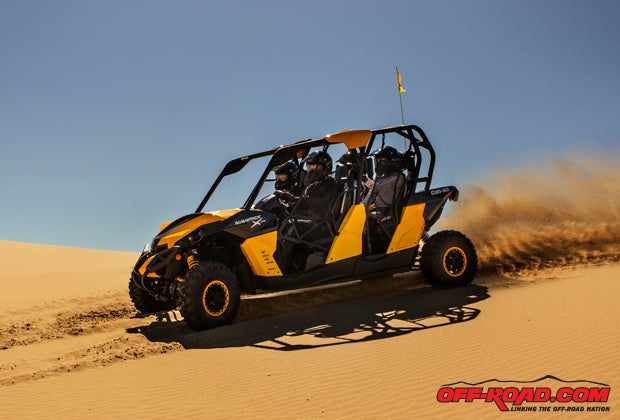
Four Fun
The big surprise announcement form Can-Am is the four-person Maverick MAX 1000R, which technically will be listed as a 2014 model. The MAX will features the same engine and features found on the Maverick 1000R, and it will also be offered in both a standard package and an X rs performance option.
The Maverick MAX 1000R will have a wheelbase that is 29.5 inches longer than the standard Maverick. Its total wheelbase measure will be 113.8 inches, and Can-Am goes on to say it will offer 6.4 inches more inches of space than the Polaris RZR XP-4 900.
The rear seats feature the same basic ergonomic design as the front passenger seat, yet the main difference is the rear seats are raised 3.5 inches higher to provide good passenger visibility while riding. Aside from installing a total of four handholds for the rear passengers, Can-Am says it configured the rear section to improve the entry and exit of the vehicle. Although the news was released on this 2014 model along with the 2013 Maverick, the 2014 Maverick MAX 1000R wonít be available until the summer of 2013.
More Photos:
2013 Maverick 1000R, 2014 Maverick MAX Gallery
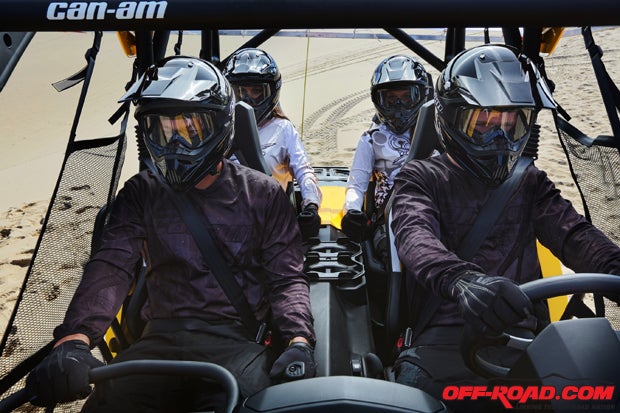
Can-Am also announced the pricing of the new models (the MAX pricing will be available later, however). The 2013 Can-Am Maverick 1000R will have an MSRP of $15,999, while the Maverick 1000R X rs will have an MSRP of $17,499. For more information on the new models and the rest of Can-Amís lineup, visit http://www.canamoffroad.com/.


 Your Privacy Choices
Your Privacy Choices